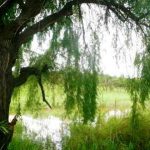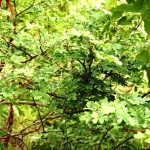TREE LIFE
February 2007
MASHONALAND CALENDAR
Sunday 18th February 2007: Ruzawi School, near Marondera. The last time we visited this interesting area was in September 2005; a hot, dry, time with plenty of flowering trees. This month’s visit, in the rainy season, will be a complete, and no doubt interesting, contrast. Once again our hosts will be Maureen and Buck Williams. We will explore the high rainfall miombo woodland typical of that area.
Meeting time: 9.30 a.m.
Saturday 24th February 2007: Elcombe, Kingsmead Road. Meeting time: 2.30 p.m.
MATABELELAND CALENDAR
Please contact Jean Wiley or Gill Short for details of the next Matabeleland function.
EDITORIAL
From May this year, there will be two vacancies on the Tree Society Committee. Rob Burrett and Adele Hamilton-Ritchie have resigned with effect from the A.G.M.
Firstly, I would like to publicly thank both of them for all their work on behalf of the Society over a number of years. They will both be hard to replace.
It follows from this that we need further people to help in running the Society. Possible jobs include administering membership records, editing Tree Life and sending it out each month, taking minutes of meetings, etc.
Involvement with the Society need not be onerous. The only qualifications needed are energy and enthusiasm. A reasonable level of computer literacy is also useful for some jobs.
Ultimately, unless more people get involved it will not be possible to maintain the level of activities that we do at present and we will need to reduce the number of outings and the frequency of Tree Life.
Mark Hyde – Chairman
JACANA YACHT CLUB, LAKE CHIVERO: 12 NOVEMBER 2006
Jacana Yacht Club, on the shores of Lake Chivero, was our venue on this hot Sunday in November. As far as I am aware this is a new place for the Society and thanks must go to Richard Oulton for organizing the outing. We also had a warm welcome from the managers, Mr and Mrs Fenner and the place has some nice facilities – e.g. chairs on a green lawn to sit on and with an adjacent bar.
The general appearance of the area is typical of Lake Chivero with enormous termite mounds, in some cases bearing large trees, and at this time of the year a general lack of ground cover. The altitude is a bit lower than Harare, at 1370 m (4500 ft.).
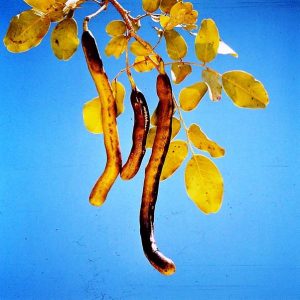
Swartzia madagascariensis. Photo: Mike Bingham. Source: Fora of Zimbabwe
We started near the club house with a small specimen of Bobgunnia madagascariensis, the Snake bean. Better known to most of us as Swartzia madagascariensis, this relatively new name of Bobgunnia does not seem to have been taken up with much enthusiasm in the southern African literature. Meg Coates Palgrave uses Swartzia and firmly reduces Bobgunnia to synonymy. The checklist of southern African plants also uses Swartzia, as also does the Zimbabwe checklist; however, the new checklist of sub-Saharan Africa does use Bobgunnia. As is well known, the specific name is a misnomer as the species does not occur in Madagascar.
Somebody mentioned that if cattle eat the pods, they produce red urine. However, apparently the species is not poisonous to them. Meg, in her book, notes that it does appear to be poisonous to fish.
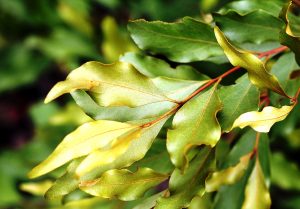
Euclea divinorum. Photo: Bart Wursten. Source: Flora of Zimbabwe
Nearby was Euclea divinorum, Diamond-leaved Euclea or Magic guarri. The habitat here was that of shade on a termite mound, which is very typical for this species. It is an evergreen and has diamond-shaped leaves that are markedly wavy at the edges. Flowers are tiny, creamy-white and occur in clusters in the leaf axils.
We also saw a Senna singueana, Winter-flowering senna, and remarked on its compound leaves which are of course 1-pinnate. Someone asked whether 2- or 3-pinnate leaves occur and whether even higher levels, such as 4-pinnate leaves exist.
Interestingly, nearby there was a probably planted Melia azedarach with 2-pinnate leaves. Indeed, 2-pinnate leaves are fairly frequent – e.g. many Mimosoideae such as Acacia and Albizia. 3-pinnate leaves in trees are less frequent though. Melia might just extend to 3-pinnate, but it didn’t on the specimen we looked at; just possibly the Kenya Coffee Shade tree (Acrocarpus fraxinifolus) might also do it.
However, for 3- or 4-pinnate leaves (or fronds) one has to turn to the ferns. I know of no species, whether a fern or otherwise, which is more dissected than 4-pinnate.
Not much further on was a specimen of Gardenia volkensii (Woodland gardenia). This is the one of our two common savanna gardenias with smooth leaves – easily detected by applying the tongue test. (Smooth leaves are volkensii; rough are ternifolia). It belongs to the family Rubiaceae and tends to have both leaves and branches in whorls. It also has fruits that are somewhat ribbed, the ribs running longitudinally.
At this point we found Boscia salicifolia (Willow-leaved shepherds-tree) on a termite mound. The specific name salicifolia means that the leaves resemble a Salix or willow, which generally implies narrow leaves (although not all Salix species do have narrow leaves) and this is true in the case of this species. Like many species in the Capparaceae, this species usually occurs on termitaria.
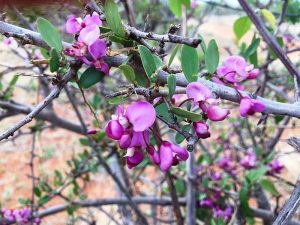
Securidaca longipedunculata. Photo: Wikipedia
We then walked out of the fenced area around the club and crossed the road into some very dry woodland. Here were some different species: Euphorbia ingens (Giant euphorbia), Strychnos cocculoides (Corky-bark monkey-orange), Securidaca longipedunculata (Violet tree), Gardenia ternifolia (the other Gardenia!), Rhoicissus revoilii (Warty grape) and Vangueriopsis lanciflora (False-medlar).
In the dry woodland, there was, in addition to the orchid Eulophia nyasae, an unknown (to me) species of Eulophia in flower.
From there we walked back to the Club for lunch. Our afternoon walk was also within the Club and took us along the shoreline. Here was the rampaging weedy invader Hydrocotyle ranunculoides, and also a different aquatic, probably a species of Eichhornia, with white flowers on short stems hidden away at the base of the petioles.
In summary, it was an interesting day at a place to which we must return in the future.
-Mark Hyde
The following article by Dr. Hugh Glen is from the South African magazine The Gardener, September 06, page 17. www.thegardener.co.za
IT’S ALL GREEK TO ME!
The other day I met an almost mythical character – a reader of this column! Anyway, this lad spent some time telling me how he wished he’d paid attention in Latin class so he’d know what the names mean. “But they’re not all Latin or Greek”, said I.
“Oh, what else?” he asked.
“Arabic, isiXhosa, kiSwahili, Nahuatl, Malayalam and Japanese come readily to mind, and I’m sure there are many others. If one takes the time to look for them.”
This month, let’s take a look at a few…
The code that has been the rather obvious foundation of the columns of the last few months says a plant name may come from any source whatever; with a few exceptions (mainly that I can’t call my new plant by a number or nova). Even the requirement that it be pronounceable in Latin is a recommendation and not a stipulation that carries the force of law. Presumably this is how a Mexican botanist got away with calling his new orchid Mormodes coztixcohuitl, which is Nahuatl (Aztec to you and me) for yellow-flowered, or so I am told.
Visitors to Eastern Cape forests may be so lucky to see a small, rather rare, thorny tree (which should be grown more often that it is) that rejoices in the isiXhosa name of umThiza. At Tokai Arboretum, one of Cape Town’s lesser known attractions, you can see a tree of … Umtiza listeriana.
Some years ago Dr Verdcourt, the great Kew expert on East African plants, described a new species under the name Cyphostemma platypus. The specific epithet means ‘broad-based’. Unfortunately, someone else used the same name for a different plant just a few months earlier, so the Verdcourtian one needed a new name. Having lived for many years in Nairobi, our noble hero was equal to the challenge, and his plant now rejoices in the name of Cyphostemma jiguu (broad-based still, but in kiSwahili this time).
Arabic names are a dime a dozen, especially if your work involves east Africa or, obviously, the Arabian Peninsula. Here’s a list to go on with:
Abelmoschus (abu-el-mosk = father of musk), Berberis (the Barberry), Cadaba (kadhab; one attractive species is called Swart Storm in the Little Karoo), Cadia (kadi, an attractive Ethiopian tree with strange flowers; there used to be one in Pretoria National Botanic Garden), Catha (khat, the stimulant leaves of C. edulis), Coffea (kahwah and surely everybody knows what that is!) … and so on; there are dozens, even here in South Africa.
Malay names here tend to be mostly palms in gardens, which makes sort-of sense. They include Arenga (areng; one species yields ‘jaggery’ – palm sugar – that can be bought at Indian spice shops), Caryota no (no, a huge fishtail palm), Bambusa bambos (apparently the genus name is a group of Malay bamboos, and the specific epithet is one individual), Actinorhytis calapparia (from kelapa, a coconut), and there are many more.
Probably the most familiar Japanese botanical name to foreigners is Ginko biloba, from gin-kyo meaning ‘silver apricot’. Sadly, the tree is almost extinct in the wild in China, and gin-kyo (its seventeenth-century name) is no longer used in Japan. Another Japanese name, and one that should be better known in this country, is Diospyros kaki (kaki-no-ki, the persimmon tree) but because of someone else’s good marketing, its fruit appears at the greengrocer’s as ‘Sharon Fruit’. Either way, it’s more than edible, though possibly not as much as the price suggests. For climatic reasons, most of the other plants with Japanese names in South African gardens are very rare indeed.
Did you know that some of our indigenous garden plants have Indian and Sinhalese (Sri Lankan) names? Take Adhatoda for example, or take Duvernoia adhatodoides if you prefer, but then read May’s column on –oides first.
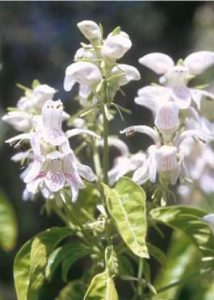
Duvernoia adhatodoides. Plantzafrica.com
The vital part of the name is Adhatoda, which comes from the Tamil and Sinhalese ada, a goat and thodai, not-touch. It is said that the leaves are so bitter that not even a goat will touch them. One of the commoner small trees of dryish Lowveld scrub forest has the jaw-breaking scientific name Catunaregam, which doesn’t even look Latin. And indeed it isn’t. It is Tamil: kattu, wild and naregam, an edible species of Citrus. This is another name recorded in the seventeenth century that has gone out of use since then.
If I included any more languages and names, I imagine we’ll all come down with acute mental indigestion. So before you reach for the antacids, what point can we take away from all this? The one I leave you with is that if you collect plants and their names carefully (leave out the weeds, however enticing the names), you can end up with a linguistic and necessarily also floristic world tour in one garden, and that garden needn’t be enormous.
I would like to thank Brad May for the inspiration to write this column, and no doubt the editorial team would like to thank Brad for inspiring me to get it in on time (almost a first!).
Article written by Dr. Hugh Glen, Specialist Scientist and Collections Coordinator at the KwaZulu-Natal Herbarium, a division of the South African National Biodiversity Institute. Visit www.sanbi.org for more information on the work done at SANBI.
-Mark Hyde – Chairman


